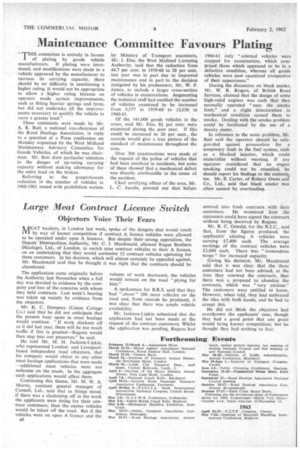Maintenance Committee Favours Plating
Page 42

If you've noticed an error in this article please click here to report it so we can fix it.
" THIS committee is entirely in favour 1 of plating by goods vehicle manufacturers. If plating were introduced, and modifications were made to a vehicle approved by the manufacturer to increase its carrying capacity, there should be no difficulty in sanctioning a higher rating. It would not be appropriate to allow a higher rating because an operator made certain improvements, such as fitting heavier springs and tyres, but did not undertake all the improvements necessary to qualify the vehicle to carry a greater load,"
These comments were made by Mr. A. R. Butt, a national vice-chairman of the Road Haulage Association, in reply to a question at a Press conference on Monday organized by the West Midland Maintenance Advisory Committee for Goods Vehicles, of which he was chairman. Mr. Butt drew particular attention to the danger of up-rating carrying capacity without making allowance for the extra load on the brakes.
Referring to the proportionate reduction in the number of vehicles in 1960-1961 issued with prohibition notices by Ministry of Transport examiners, Mr. J. Else, the West Midland Licensing Authority, said that the reduction from 44.7 per cent. in 1959-60 to 28 per cent. Last year was in part due to improved maintenance and in part to the decision instigated by his predecessor, Mr. W. P. James, to include a larger cross-section of vehicles in examinations. Augmenting the technical staff had enabled-the number of vehicles examined to be increased from 9,577 in 1959-60 to 12,030 in 1960-61.
Of the 141,000 goods vehicles in the areas, said Mr. Else, 81 per cent. were examined during the past year. If this could be increased to 20 per cent., the records would give a true picture of the standard of maintenance throughout the area.
Over 300 examinations were made at the request of the police of vehicles that had been involved in accidents, but none of these showed that a mechanical defect was directly attributable to the cause of the accident.
Chief certifying officer of the area, Mr. L. C. Jacobs, pointed out that before 1960-61 only "selected vehicles were stopped for examination, which cornprised those which appeared to be in a defective condition, whereas all goods vehicles were now examined irrespective of their appearance."
During the discussion on black smoke, Mr. W. R. Rogers, of British Road Services, claimed that the design of some high-rated engines was such that they normally operated "near the smoke limit," and a slight deterioration in mechanical condition caused them to smoke. Dealing with the smoke problem could be facilitated by the use of a density meter.
In reference to the same problem, Mr. Butt said the operator should be safeguarded against prosecution for a temporary fault in the fuel system, such as a blocked injector, which could materialize without warning. If any operator considered that an engine smoking could not be remedied, he should report his findings to the committee. Mr. E. Carter, of Rubery Owen and Co., Ltd., said that black smoke was often caused by overloading.




























































































































